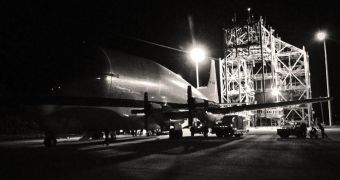Officials with the American space agency announce that the heat shield for the NASA Orion Multipurpose Crew Vehicle (MPCV) has finally been delivered to the Kennedy Space Center (KSC), in Florida, from the Lockheed Martin Waterton Facility, near Denver, Colorado.
This critical component was delivered aboard the agency's Super Guppy aircraft, which is capable of transporting atypical payloads. Super Guppy landed in Florida late Friday night, on December 4, and its cargo is scheduled to be removed today, December 5.
The heat shield will be installed onto the first Orion MPCV in March 2014, in anticipation of the spacecraft's first test flight, currently scheduled for September 2014. Orion will be NASA's next flagship spacecraft following 2018, when development of the Space Launch System rocket concludes.
The heat shield departed the Lockheed Martin facility in January, after engineers with the company were able to complete the titanium skeleton and carbon fiber skin that will underlie its structure. The component was then delivered to a Textron Dense Systems facility, near Boston, Massachusetts.
“The heat shield completion and delivery to Kennedy, where Orion is being prepared, is a major step toward Exploration Flight Test-1 next year,” says the deputy associate administrator for exploration systems development at NASA Headquarters, Dan Dumbacher.
“Sending Orion into space for the first time is going to give us crucial data to improve our design decisions and develop Orion to send humans on future missions to an asteroid and Mars,” he adds.
NASA is mandated to land astronauts on a near-Earth asteroid by 2025, and to put a man on the Red Planet by the early 2030s. The agency chose to do this with the SLS/Orion spacecraft duo. The SLS is the largest rocket America ever designed and considered building.
“Many people across the country have poured a tremendous amount of hard work into building this heat shield. Their efforts are a critical part of helping us understand what it takes to bring a human-rated spacecraft back safely from deep space,” explains Mark Geyer, manager of the Orion Program.
While at Textron, the heat shield received a fiberglass-phenolic honeycomb structure on top of its carbon fiber skin. Each of the 320,000 holes in the structure was then filled with Avcoat, an ablative material. The entire heat shield was then exposed to X-rays, and sanded down to meet requirements.
When Orion returns to Earth after its maiden, unmanned voyage, it will encounter temperatures exceeding 2,204 degrees Celsius (4,000 degrees Fahrenheit), at speeds of around 32,200 kilometers (20,000 miles) per hour. The heat shield will have to endure these conditions without failing.

 14 DAY TRIAL //
14 DAY TRIAL //